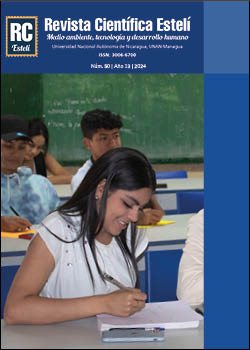Microplastics in a lagoon ecosystem of the Nicaraguan humid tropics and their impact on Crassostrea rhizophorae populations
DOI:
https://doi.org/10.5377/esteli.v13i50.18483Keywords:
Lagoon ecosystem, impact on biota, microplastics, sedimentAbstract
The objective of this study was to identify microplastics in water, sand, sediment and biota (Crassostrea rhizophorae) in the Houn Sond bar, south of Bluefields lagoon, Nicaragua. Since there are no previous studies to reference the effects, this analysis provides fundamental data. Water samples were obtained using a 65 µm Bongo net at a speed of 3 km/h, with three replicates; sand samples were obtained using a transect along the high tide coastline; sediment samples were obtained using a 6“ x 6” inch Van Veen dredge; and oyster samples were obtained from randomly identified banks. Microplastic identification was performed by water saturation with sodium chloride and stereoscopic observation, while oyster samples were analyzed by chemical digestion with 30% H2O2. Out of 1,296.073 m³ of filtered water, 0.475 g of microplastics and a 0.022 g rubber particle were identified, the most abundant color being off-white with 0.329 g. In the sand, 23.282 g of microplastics were found, with a higher presence of off-white (13.473 g). No microplastics were observed in the sediment or oyster samples.
Downloads
288
HTML (Español (España)) 77
Published
How to Cite
Issue
Section
License
Copyright (c) 2024 Revista Científica de la FAREM-Estelí

This work is licensed under a Creative Commons Attribution-NonCommercial-ShareAlike 4.0 International License.
© Revista Científica de FAREM-Estelí

